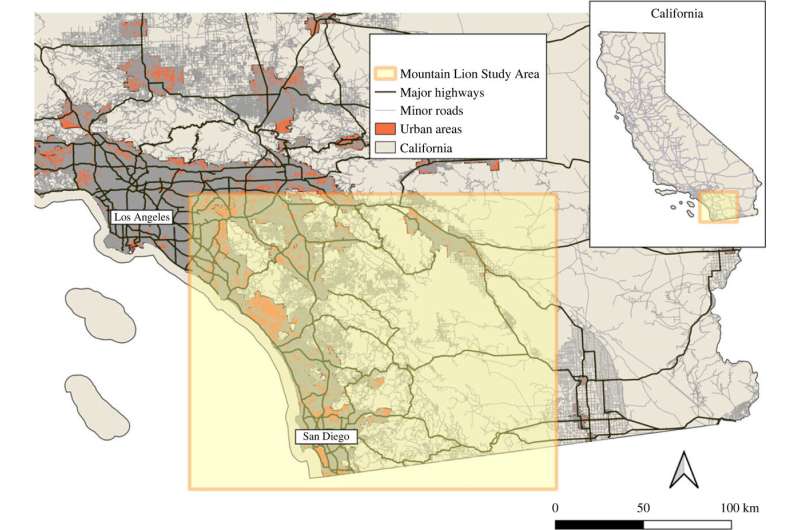This article has been reviewed according to Science X's editorial process and policies. Editors have highlighted the following attributes while ensuring the content's credibility:
fact-checked
peer-reviewed publication
trusted source
proofread
City and highway lights threaten mountain lion habitats

City lights shine all night amid the bustling traffic, businesses and neighborhoods of Southern California, one of the most populated areas that mountain lions call home.
A study from the University of California, Davis, found that mountain lions avoid places with artificial light, even during the day. The finding adds to the list of challenges faced by the big cats in the region, where scientists have warned they may face extinction within decades.
The new study, published in the journal Philosophical Transactions of the Royal Society B, carries implications for the conservation of this sensitive species, and for wildlife crossing proposals. The authors described ways to limit light impacts in their design guidance for the Wallis Annenberg crossing over U.S. Highway 101, which broke ground in April 2022, and for a newly proposed wildlife crossing at Interstate 15 near Temecula.
"Well-lit streets, neighborhoods and commercial areas will reduce and fragment the areas available to mountain lions to move around," said senior author Fraser Shilling, director of the UC Davis Road Ecology Center in the Institute of Transportation Studies. "It's not just the outsized human footprint that is squashing lion habitat, but the extended glow from that footprint, too."
Bright lights, big kitty
Large carnivores cover broad territories, which are increasingly compromised by roads, residential development and artificial light. The authors sought to unravel how artificial light at night and road proximity affect how mountain lions select their habitat in a heavily populated area like Southern California, where more than 20 million people live.
They used the locations of 102 radio-collared mountain lions, which were monitored in California between 2001 and 2022 by wildlife veterinarians with the UC Davis School of Veterinary Medicine, the California Department of Fish and Wildlife and other partners. They modeled the lions' distribution relative to nearby artificial lights, developments, sky glow (diffuse light in the night sky from both natural and ground-based sources), and moonlight.
Illuminating factors
The study found that sky glow and moonlight did not influence the presence of mountain lions, but artificial light at night from nearby ground sources did.
"Overall, we found that mountain lions try to avoid zones lit artificially, possibly to avoid interactions with humans," said lead author Rafael Barrientos, an ecologist with the Universidad Complutense in Madrid, Spain, and visiting scientist at the Road Ecology Center. "This can have cascading effects on the redistribution of the species in the region, as well as the benefits wildlife provide in this ecosystem."
Previous studies by UC Davis and colleagues have shown that traffic-lion collisions and freeways that cut off Southern California mountain lions from potential mates have severely decreased their genetic diversity and threatened their existence.
"Our research has shown that even when structures exist to allow mountain lion passage under freeways, the light and noise can deter mountain lions from use of these safe crossing structures," said mountain lion expert and co-author Winston Vickers, a wildlife veterinarian with the UC Davis School of Veterinary Medicine and its Karen C. Drayer Wildlife Health Center. "The findings in this analysis should increase the incentive for highway agencies to block light that spreads into the habitat from roads at crossing structures.
"On the positive side, the deterrent effect of light might be put to positive use to prevent livestock losses to mountain lions, and the subsequent killing of mountain lions in response."
More information: Rafael Barrientos et al, Nearby night lighting, rather than sky glow, is associated with habitat selection by a top predator in human-dominated landscapes, Philosophical Transactions of the Royal Society B: Biological Sciences (2023). DOI: 10.1098/rstb.2022.0370
Journal information: Philosophical Transactions of the Royal Society B
Provided by UC Davis



















